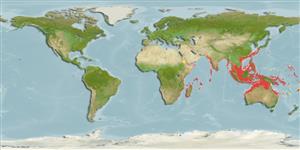Common names from other countries
Classification / Names / Names
ชื่อสามัญ | ชื่อพ้อง | Catalog of Fishes (gen., sp.) | ITIS | CoL | WoRMS
Environment: milieu / climate zone / depth range / distribution range
นิเวศวิทยา
; ระดับความลึก 0 - 250 m (Ref. 349). Tropical
Indo-West Pacific: from East Africa, including the Red Sea and the Persian Gulf, to eastern Indonesia; north to the Philippines and south to southern Indonesia.
Length at first maturity / ขนาด / น้ำหนัก / Age
Maturity: Lm ? range ? - ? cm Max length : 13.0 cm ShH เพศผู้/กระเทย; (Ref. 349); common length : 10.0 cm SHW เพศผู้/กระเทย; (Ref. 349)
Occasionally collected in shrimp trawls. Shell used in shellcraft (Ref. 349). Found on the bottoms of the continental shelf and upper slope. Also from shallow subtidal waters (Ref. 349). Members of the family Xenophoridae feed directly on sediments (Ref. 107881), collecting tiny detritus (Ref. 349) and foraminiferans (Ref. 104247).
Life cycle and mating behavior
วัยเจริญพันธุ์ | การสืบพันธุ์ | การวางไข่ | เซลสืบพันธ์ของเพศเมีย(ไข่) | ความดกของไข่ | ตัวอ่อน
Members of the order Neotaenioglossa are mostly gonochoric and broadcast spawners. Life cycle: Embryos develop into planktonic trocophore larvae and later into juvenile veligers before becoming fully grown adults.
Poutiers, J.M. 1998. (Ref. 349)
IUCN Red List Status (Ref. 130435)
CITES status (Ref. 108899)
Not Evaluated
Not Evaluated
Threat to humans
Harmless
Human uses
| FishSource |
เครื่องมือ
ข้อมูลเพิ่มเติม
Age/SizeการเจริญเติบโตLength-weightLength-lengthสัณฐานวิทยาตัวอ่อนอุดมสมบรูณ์
แหล่งที่มาจากอินเตอร์เน็ต
Estimates based on models
Preferred temperature
(Ref.
115969): 23.1 - 28.6, mean 27.3 (based on 918 cells).
Vulnerability
Low vulnerability (10 of 100).
Price category
Unknown.
